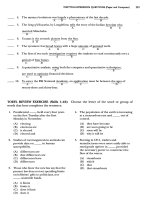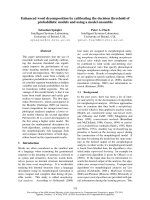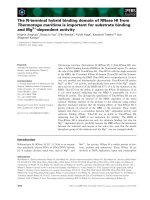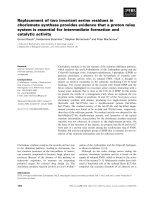Carving Foam is great for Sculpture, Models, and large scale pattern work! pdf
Bạn đang xem bản rút gọn của tài liệu. Xem và tải ngay bản đầy đủ của tài liệu tại đây (1.92 MB, 5 trang )
Carving Foam is great for Sculpture,
Models, and large scale pattern work!
These pieces, along with the figure used in this book, were part
of an installation titled Major Impact.
TJ has used this basic process for large industrial
models and forms as well. Any type of project
you want to create in 3D can benefit from this
read. Whether you are a skilled sculptor or just a
curious person with a project to consider, Tj’s
insights will be helpful to you.
They were all carved in foam. Various finish
and mold techniques were tried for the final
works over a period of eight years.
Tj discovered how to
produce finished works
directly from these
simple materials using
polymer modified
concrete formulas.
The mold form for this Japanese soak tub and the patterns for the
flaming fender skirts on this hot rod Lincoln were carved using these
same techniques.
1
To the sculptor:
The 3 book series is a step by step explanation for creating big sculpture for very little money.
Tj’s studio photographs and notes have been laid out to best show the process he developed over several
years. The text includes discussion on tools and techniques as they are used on the pieces, as well as errors
and how to fix them. All three books are intended as studio guides for experienced sculptors, yet they
stress simple, inexpensive tools and materials. Some items reappear from earlier books for the artist who
has just that volume. The final book illustrates the formula developed for stone coating the pieces with a
new process using polymer modified concrete.
Creating a Block for carving the piece (covered in Book 1, Scaling Up)
About foam 7
Tools and their uses 9
1. Lay out, line work, basic carving technique 12
2. Sneaking up on the form 14
Fixtures for holding 17
3. Hogging 19
Viewing the work 20
4. Carving major forms 21
Adding on to the block 22
Carving progression- 24
5. Errors oversights and additions 25
6. Piecing in intricate areas 29
Finishing methods & materials choices- 39
7. Sanding 40
8. Gaps 42
Coating the Piece This process is in Book 3, Stone Coating
2
C Novus Resource Inc. no reproduction without permission - SculptureByTj.com
Content - The Carving Process Outlined
Foam is often thought of as a cheap, weak material. It is inexpensive and you can snap an appendage
easily, but in compression this stuff is fantastic. It will hold hundreds of pounds of force. Cheap means
that you can use a lot for larger pieces and afford to throw away scrap and mistakes. Speed is a huge
plus. Foam can be cut, glued and shaped extremely quickly, enabling a sculpture to proceed at a rapid
pace. The fidelity that you can get with a little practice is astonishing. Dow extruded foam plank will
sand to a smooth surface that will satisfy most pattern making needs. It is available at your DIY store.
There are certain techniques
required for working with
foam. It must be handled
with a delicate touch when
carving and sanding to avoid
“tearing”. Once you have
most of the surface complete
you must be careful not to
scar it before the surface coat
goes on. But practice will
make you good at this.
Changing your piece is also
quite easy. Cut away, flatten
the area and glue in a new
piece. Your change is done in
minutes. Light weight means
easy lifting, moving and
repositioning with no heavy
equipment needed.
The final advantage comes from breakthroughs in concrete formulas. With a thin skin of glass-filled,
polymer-modified cement, your foam carving becomes a light weight rock, able to withstand a lot
more abuse than you would think due to great compressive strength.
3
C Novus Resource Inc. no reproduction without permission - SculptureByTj.com
Advantage of Foam
Carving Major Lines Against Secondary Forms
21
C Novus Resource Inc. no reproduction without permission - SculptureByTj.com
Some lines come from a panel edge. Some are drawn on a
surface and V cut, deepened and cut again after new detail is
drawn on. (Note the start of wavy detail just below the red mark).
At this point you are blocking in major forms and getting your proportions and major lines where they need
to be. Slice away material constantly checking the drawing, your work lines, and the maquette for
reference. Try to keep section labels visible as long as possible and constantly place marks on the surface
for guides. (The blue line along torso and leg represents edge of profile and needs to be cut in).
Bring the whole piece along at the same
rate of refinement. It is important not to
go too far in one area. This way, if you have
to make a major change you do not loose
too much effort.
Here a major step has
been defined and
deepening the detail
below has
been started
(Same area later).
Piecing in Intricate
Detail Areas
Working these details as
separate pieces allows the
intricate development of an
area like this form surrounding
the thumb. The hand is carved
sanded and set in, and so is the
form just beneath the thumb.
The areas marked in red just to
the left had material removed.
This was a lot easier without
the hand in the way.
5









